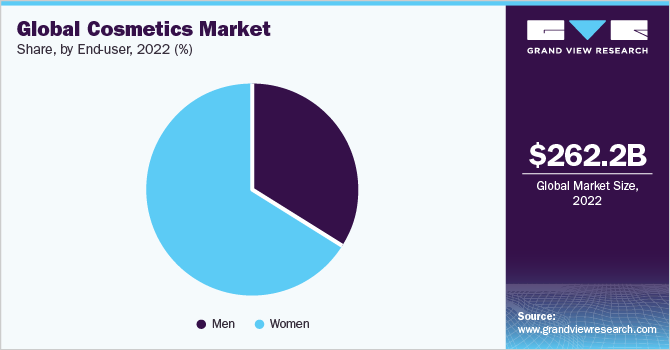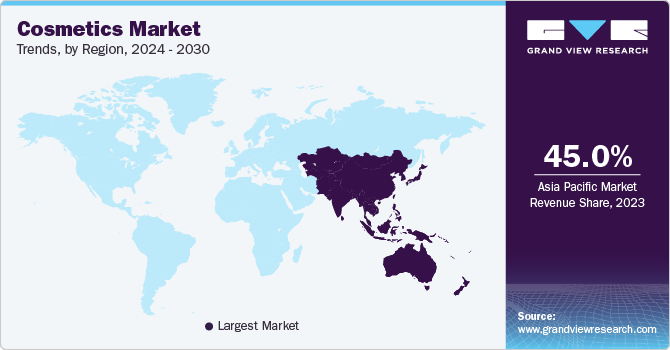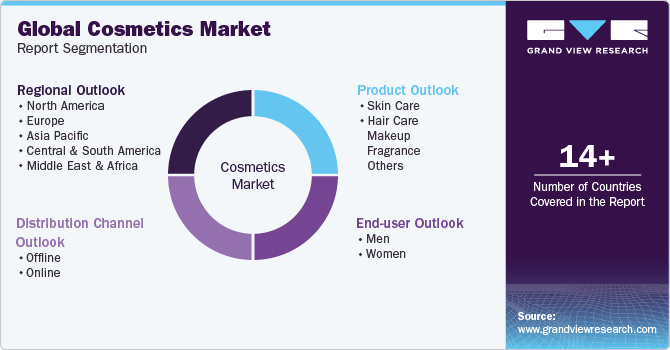- Home
- »
- Beauty & Personal Care
- »
-
Cosmetics Market Size, Share & Growth Analysis Report, 2030GVR Report cover
![Cosmetics Market Size, Share & Trends Report]()
Cosmetics Market Size, Share & Trends Analysis Report By Product (Skin Care, Hair Care, Makeup, Fragrance), By End-user (Men, Women), By Distribution Channel, By Region, And Segment Forecasts, 2023 - 2030
- Report ID: GVR-4-68039-924-6
- Number of Pages: 82
- Format: Electronic (PDF)
- Historical Range: 2017 - 2021
- Industry: Consumer Goods
Report Overview
The global cosmetics market size was valued at USD 262.21 billion in 2022 and is expected to expand at a compound annual growth rate (CAGR) of 4.2% from 2023 to 2030. One of the key factors driving the market expansion during the forecast period is the widespread increase in the adoption of skincare and personal care products along with the rise in the global aging population. Rising fashion trends and considerable product innovation in hair color and other skincare product formulations and packaging all contribute to the market's expansion. Yet over the projection period, the adverse consequences of routine use of cosmetic goods due to the inclusion of dangerous chemicals are anticipated to limit market expansion.

The Covid-19 epidemic resulted in a decrease in cosmetic product sales revenue for the key market players, which had subsequent effects. As an example, L'Oréal S.A. estimated that the COVID-19 pandemic-related tough environment caused net sales to decline by roughly 7.0% in fiscal 2020. Nonetheless, the global cosmetics industry is anticipated to rebound and have significant growth in the future as a result of restarted activities, sales, commerce, and manufacturing around the world.
A considerable increase in brand recognition and the influence of cosmetic items through social platforms are anticipated to drive growth during the forecast period. The growing consumer preference for natural products, combined with increased knowledge of natural ingredients-based cosmetics and their impact on the body continue to drive the market expansion. The industry is experiencing considerable expansion as a result of the aging population since older consumers are increasingly using anti-aging treatments and hair dye to change the color of their hair.
A significant opportunity for the market is expected to emerge in the near future as a result of the global trend toward organic cosmetics goods. Consumer preference for organic cosmetics over products with chemical bases is supported by growing knowledge about these goods and their beneficial effects on the skin, which is further fueling the market expansion.
Cosmetics Market Size, Share & Growth Insights:
- The U.S. cosmetics market size was estimated at USD 54.3 billion in 2021.
- The global market size is expected to grow at a CAGR of 4.2% from 2023 to 2030.
- Asia Pacific accounted for the largest market share of nearly 44.0% in 2022.
Celebrities and millennials continue to favor fragrance products, which is expected to contribute to the market's expansion over the forecast period. The future market potential will also be greatly influenced by cosmetic manufacturers' increasing innovation and product development.
Over the forecast period, another motivating factor is the rising awareness of skincare cosmetics products and their beneficial effects on the skin. Moreover, growing financial independence among women and increasing beauty awareness among men are important factors influencing the demand for cosmetics items over the predicted period.
Product Insights
Based on the product, the global cosmetics industry is further classified into skincare, haircare, makeup, fragrance, and others (hygiene and personal care products). Among these, the skincare segment contributed to a larger market share of more than 38% in 2022. The significant trend toward skincare cosmetics such as face cream, powder, and sunscreen lotions due to wide availability in different varieties is a major factor that contributes to its largest market share. Moreover, the significant popularity of personalized skincare products among developed economies such as the US, U.K., and others further contributed to the segmental growth. Moreover, the availability of skin care products with active ingredients that have healing and nurturing properties further supported the growth of the market.
The hair care segment is expected to grow with a significant CAGR of 3.9% from 2023 to 2030 in terms of revenue. The significant rise in the fashion trends of changing hair colors with proper hair cosmetics across the globe is one of the major factors that propel the market growth during the forecast period. Therefore, the ease of the application of hair color cosmetics is further projected to grow significantly in the upcoming years. Moreover, the significant rise in hair fall and scalp-related issues among people across the globe is further projected to contribute to the growing demand for hair care products over the forecast period.
Distribution Channel Insights
Based on the distribution channel, the global cosmetics industry is further divided into offline and online. Among these, the offline segment contributed to the largest market share of over 66.2% in 2022. The main factor that contributed to the substantial share of the market is the strong preference of consumers toward offline retail outlets that sell cosmetics. Also supporting the growth of sales in the offline channel sector was the simple accessibility of cosmetics and personal care goods in brick-and-mortar retail establishments, including department stores, specialty-multi retailers, and salons and spas.
Moreover, the online segment is expected to grow with a significant CAGR of 3.7% over the forecast period. The expansion of the e-commerce sector in emerging markets is a key driver of market growth. Online browsing and shopping for cosmetics products are becoming more popular in China and India. Furthermore, it is anticipated that the industry will have plenty of prospects in the near future thanks to the expanding relationship between big e-commerce companies and producers of cosmetic goods in emerging economies. In addition, it is anticipated that the industry would have plenty of opportunities in the near future due to the expanding popularity of e-commerce websites and the increased use of smartphones worldwide.
End-user Insights
Based on the end-user, the global cosmetics industry is further classified into men and women. Among these, the women segment contributed to a larger market share of over 62.05% in 2022. One of the primary factors that significantly contributed to the largest market share was the strong trend among women toward skincare and cosmetics products for makeup and hair. The fact that women spend more money on cosmetics and beauty items than men do also helps explain why the women segment holds the highest market share. Because of this, a sizeable part of women throughout the world utilize various cosmetics goods, such as skin and hair products with natural ingredients, which further contributes to the segment's largest market share.

Moreover, the men segment is expected to grow with a significant CAGR of 4.6% over the forecast period. The growing trend toward using cosmetics products among men across the globe is one of the major factors that drive market growth. Moreover, the growing trend toward trendy skincare, haircare, and fragrance products among men is further projected to enhance the market growth during the forecast period. Furthermore, the significant brand endorsement by celebrities further encourages the men population toward cosmetic products that provide significant growth opportunities to the market.
Regional Insights
In the global cosmetics industry, Asia Pacific dominated the market revenue share in 2022, accounting for nearly 44% of the total revenue. The rising consumer expenditure on cosmetics and personal care items as well as the popularity of elevated cosmetics brands among celebrity guests are the main drivers of commercialization. Additionally, the expanding industrial growth is further bolstered by the sales increase in per capita income in emerging countries such as India, China, and others. Also, during the projection period, the personal care business in emerging nations is, creating the considerable potential for the market to thrive.

North America is expected to grow at a significant CAGR of 4.5% from 2023 to 2030. Rising skincare routine awareness, creative product branding, and advertising methods are the main drivers of the North American cosmetics industry. Growing advancements in environmentally friendly cosmetics are opening up industry expansion potential. The market expansion is, however, being severely constrained by the increasing public awareness of the negative consequences of synthetic chemicals. On the other hand, the presence of well-established offline retail chains for cosmetics products in Europe is another factor driving the market across the region.
Key Companies & Market Share Insights
The cosmetics industry continues to evolve with changing trends, and a desire to adapt among manufacturers. To gain a competitive edge in the market, players tend to launch new strategies regularly. Key players are focused on increasing investments in advertisements through social sites to increase awareness regarding cosmetics in the market.
-
In September 2021, Coty Inc. announced the partnership agreement with Perfect Corp. for the integration of a suite of AI and AR practices into the digital marketing toolkits of its cosmetics brands.
-
In November 2021, a collaboration between The Estée Lauder Companies Inc. and Florida A&M University for a new talent and development program was announced. The program aimed to create the next generation of black beauty professionals in travel retail. This change was consistent with their commitment to racial equity. This made it possible for the business to partner with Florida A&M University for an exclusive internship and scholarship program.
- Celebrity cosmetics brand Rare Beauty is expected to be launched in India by June 15, 2023. The brand, founded by Selena Gomez in 2019, is currently ranked among the top 3 celebrity makeup brands worldwide and focuses on creating awareness around mental health and wellness. This move is expected to significantly boost the brand’s sales, given Selena’s large and growing fanbase in the country.
Some prominent players in the global cosmetics market include:
-
Coty Inc.
-
L'Oréal S.A.
-
Estée Lauder Companies Inc.
-
Revlon, Inc.
-
Avon Products Inc.
-
Unilever PLC
-
Shiseido Company, Limited
-
Godrej
-
Procter & Gamble
-
Beiersdorf AG
-
Henkel AG & Co. KGaA
-
Kao Corp.
-
Hoyu Co., Ltd.
Cosmetics Market Report Scope
Report Attribute
Details
Market size value in 2023
USD 272.43 billion
Revenue forecast in 2030
USD 363.80 billion
Growth rate
CAGR of 4.2% from 2023 to 2030
Base year for estimation
2022
Historical data
2017 - 2021
Forecast period
2023 - 2030
Quantitative units
Revenue in USD million, CAGR from 2023 to 2030
Report coverage
Revenue forecast, company ranking, competitive landscape, growth factors, and trends
Segments covered
Product, end-user, distribution channel, region
Regional scope
North America; Europe; Asia Pacific;Central & South America; Middle East & Africa
Country scope
U.S.; Germany; France, U.K.; China; India; Brazil; South Africa
Key companies profiled
Coty Inc.; L'Oréal S.A.; Estée Lauder Companies Inc.; Revlon, Inc.; Avon Products Inc.; Unilever PLC; Shiseido Company, Limited.; Godrej; Procter & Gamble; Beiersdorf AG; Henkel AG & Co. KGaA; Kao Corp.; Hoyu Co., Ltd.
Customization scope
Free report customization (equivalent up to 8 analysts’ working days) with purchase. Addition or alteration to country, regional & segment scope.
Pricing and purchase options
Avail customized purchase options to meet your exact research needs. Explore purchase options
Global Cosmetics Market Report Segmentation
This report forecasts revenue growth at global, regional, & country levels and provides an analysis of the latest industry trends in each of the sub-segments from 2017 to 2030. For the purpose of this study, Grand View Research has segmented the global cosmetics market report based on product, end-user, distribution channel, and region:

-
Product Outlook (Revenue, USD Million, 2017 - 2030)
-
Skin Care
-
Hair Care
-
Makeup
-
Fragrance
-
Others
-
-
End-user Outlook (Revenue, USD Million, 2017 - 2030)
-
Men
-
Women
-
-
Distribution Channel Outlook (Revenue, USD Million, 2017 - 2030)
-
Offline
-
Online
-
-
Regional Outlook (Revenue, USD Million, 2017 - 2030)
-
North America
-
U.S.
-
-
Europe
-
Germany
-
France
-
U.K.
-
-
Asia Pacific
-
China
-
India
-
Japan
-
-
Central & South America
-
Brazil
-
-
Middle East & Africa
-
South Africa
-
-
Frequently Asked Questions About This Report
b. The cosmetics market was estimated at USD 262.21 billion in 2022 and is expected to reach USD 272.43 billion in 2023.
b. The cosmetics market is expected to grow at a compound annual growth rate of 4.2% from 2023 to 2030 to reach USD 363.80 billion by 2030.
b. Asia Pacific dominated the cosmetics market with a share of around 44.7% in 2022. This is owing to the people are moving toward a healthy lifestyle and are thinking of a sustainable environment, thus preferring cosmetics made from organic and plant-based ingredients
b. Some of the key players operating in the cosmetics market include Coty Inc., L'Oréal S.A., Estée Lauder Companies Inc., Revlon, Inc., Avon Products Inc., Unilever PLC, and Shiseido Company, Limited.
b. Key factors that are driving the cosmetics market growth include the rising awareness of chemical-free cosmetics and the rising popularity of personalized skincare products.
Share this report with your colleague or friend.
![gvr icn]()
NEED A CUSTOM REPORT?
We can customize every report - free of charge - including purchasing stand-alone sections or country-level reports, as well as offer affordable discounts for start-ups & universities. Contact us now
![Certified Icon]()
We are GDPR and CCPA compliant! Your transaction & personal information is safe and secure. For more details, please read our privacy policy.
We are committed towards customer satisfaction, and quality service.
"The quality of research they have done for us has been excellent."





